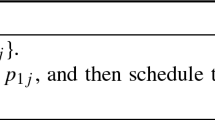Abstract
The paper investigates a new three-machine shop scheduling problem that arises from many production systems, such as the garment assembly line, etc. In such scenarios, each job consists of three operations, each of which has to be non-preemptively processed by one specific machine. In contrast with the classical three-machine shop scheduling, the processing order of the operations of each job is partially restricted. In particular, the first two operations are ordered and all the same for all jobs, while the third operation is not restricted. The objective is to minimize the makespan. We show the problem is NP-hard in the ordinary sense and present a polynomial time approximation algorithm with a worst case performance ratio of \(\frac{3}{2}\).





Similar content being viewed by others
References
Brah SA, Loo LL (1999) Heuristics for scheduling in a flow shop with multiple processors. Eur J Oper Res 113:113–122
Brucker P, Sotskov YN, Werner F (2007) Complexity of shop-scheduling problems with fixed number of jobs: a survey. Math Methods Oper Res 65:461–481
Chen B, Strusevich VA (1993) Worst-case analysis of heuristics for open shops with parallel machines. Eur J Oper Res 70:379–390
Chen B (1995) Analysis of classes of heuristics for scheduling a two-stage flow shop with parallel machines at one stage. J Oper Res Soc 46:234–244
Cheng R, Gen M, Tsujimura Y (1996) A tutorial survey of job-shop scheduling problems using genetic algorithms—I. Representation. Comput Ind Eng 30:983–997
Garey MR, Johnson DS, Sethi DR (1976) The complexity of flowshop and job shop scheduling. Math Oper Res 1:117–129
Gonzalez T, Sahni S (1976) Open shop scheduling to minimize finish time. J ACM 23:665–679
Gonzalez T, Sahni S (1978) Flowship and jobshop schedules: complexity and approximation. Oper Res 26:36–52
Johnson SM (1954) Optimal two- and three-machine production schedules with setup times included. Nav Res Logist 1:61–68
Jansen K., Sviridenko M.I. (2000) Polynomial time approximation schemes for the multiprocessor open and flow shop scheduling problem. In: STACS 2000. LNCS, vol 1770, pp 455–465
Linn R, Zhang W (1999) Hybrid flow shop scheduling: A survey. Comput Ind Eng 37:57–61
Masuda T, Ishii H, Nishida T (1985) The mixed shop scheduling problem. Discrete Appl Math 11:175–186
Riane F, Artiba A, Elmaghraby SE (1998) A hybrid three-stage flowshop problem: efficient heuristics to minimize makespan. Eur J Oper Res 109:321–329
Ribas I, Leisten R, Framinan JM (2010) Review and classification of hybrid flow shop scheduling problems from a production system and a solutions procedure perspective. Comput Oper Res 37:1439–1454
Ruiz R, Vázquez-Rodríguez J (2010) The hybrid flow shop scheduling problem. Eur J Oper Res 205:1–18
Santos DL, Hunsucker JL, Deal DE (1995) Global lower bounds for flow shops with multiple processors. Eur J Oper Res 80:112–120
Schuurman P, Woeginger GJ (1999) Approximation algorithms for the multiprocessor open shop scheduling problem. Oper Res Lett 24:157–163
Shakhlevich NV, Sotskov YN, Werner F (2000) Complexity of mixed shop scheduling problems: a survey. Eur J Oper Res 120:343–351
Strusevich V.A. (1991) Two machine super-shop scheduling problem. J Oper Res Soc 42:479–492
Su LH, Chou FD, Ting WC (2005) Minimizing makespan in a two-stage system with flowshop and open shop. Comput Ind Eng 49:520–536
Acknowledgements
We are thankful to anonymous referees for their valuable comments.
The first author was supported by Educational Commission of Zhejiang Province of China (Y201019076), the National Natural Science Foundation of China (11071220, 11001242) and Zhejiang Provincial Natural Science Foundation of China (Y6090554, Y6090175).
Author information
Authors and Affiliations
Corresponding author
Additional information
Jianming Dong is supported by Educational Commission of Zhejiang Province of China (Y201019076), the National Natural Science Foundation of China (11071220, 11001242) and Zhejiang Provincial Natural Science Foundation of China (Y6090554, Y6090175).
Appendix
Appendix
Proof of Theorem 3.1
We prove it by a reduction from the classical Partition problem: given n+1 positive integers a 1,…,a n ,b with \(\sum_{i=1}^{n}a_{i}=2b\), it is asked whether there are two disjoint subsets N 1 and N 2 of N such that \(\sum_{i\in N_{1}}a_{i}=\sum_{i\in N_{2}}a_{i}=b\)?
For any partition instance, we construct the following scheduling instance of \(F_{2}O||C_{\mathit{max}}\): 3n+1 jobs {J 0,J 1,…,J 3n } with p 10=p 20=p 30=b, p 1i =p 2,i+n =p 3,i+2n =a i and p 2i =p 3i =p 1,i+n =p 3,i+n =p 1,i+2n =p 2,i+2n =0, for 1≤i≤n. The threshold is y=3b.
We will prove that a schedule with makespan no more than y is equivalent to the YES answer to the partition instance. In fact, if the answer to the partition instance is YES, then a feasible schedule for \(F_{2}O||C_{\mathit{max}}\) can be obtained in the following way (see in Fig. 6). Job J 0 is started at time 0,b and 2b on M 1, M 2 and M 3, respectively. For M 1, we further schedule the jobs {J i |i∈N} from time b in an arbitrary order. For M 2, we process the jobs {J i+n |i∈N 1} and the jobs {J i+n |i∈N 2} from time 0 to b and time 2b to 3b, respectively. And for M 3, we schedule the jobs {J i+2n |i∈N} in an arbitrary order from time 0. Clearly, this very schedule must generate a makespan of y=3b exactly.
On the other hand, if there exists a schedule whose makespan is no larger than y=3b, then the three operations of job J 0 must be started at time 0, b and 2b. W.l.g.o., let s 10=0, s 20=b and s 30=2b. Since \(\sum_{i=1}^{3n+1}p_{2,i-1}=b+\sum_{i=1}^{n}a_{i}=3b\), there will be no idling before time 3b on M 2. Hence, both the jobs scheduled before and after J 0 must have a total processing time of b on this machine. In other words, there are two disjoint subsets N 1 and N 2 of N, such that \(\sum_{i\in N_{1}}p_{i+n}=\sum_{i\in N_{2}}p_{i+n}=b\), i.e., \(\sum_{i\in N_{1}}a_{i}=\sum_{i\in N_{2}}a_{i}=b\). This indicates that the partition instance must answer YES. □
Rights and permissions
About this article
Cite this article
Dong, J., Chen, Y., Zhang, A. et al. A new three-machine shop scheduling: complexity and approximation algorithm. J Comb Optim 26, 799–810 (2013). https://doi.org/10.1007/s10878-012-9485-8
Published:
Issue Date:
DOI: https://doi.org/10.1007/s10878-012-9485-8





